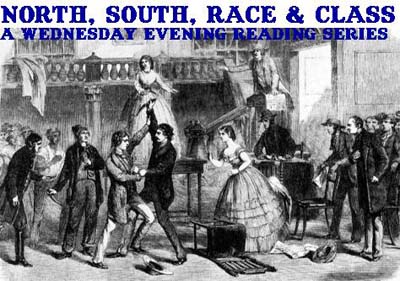Old Times There Are Not ForgottenPosted in Articles, Arts, Book/Video Reviews, Media Archive, Slavery, United States on 2014-11-23 17:08Z by Steven |
Old Times There Are Not Forgotten
The New York Times
2014-05-04
Ben Brantley, Chief Theater Critic
‘An Octoroon,’ a Slave-Era Tale at Soho Rep
Some people are paralyzed by self-consciousness. The playwright Branden Jacobs-Jenkins is inspired, energized and perhaps even set free by it.
You could say that he transforms self-consciousness into art, except then you have to ask what art is, as Mr. Jacobs-Jenkins surely would. How about into entertainment, then? No, that sounds too unequivocally pleasurable and guilt free. Well, let’s just say that Mr. Jacobs-Jenkins turns self-consciousness into theater, and that this is a lot more stimulating than it sounds.
Some degree of self-consciousness is inevitable for any latter-day dramatist taking on Dion Boucicault’s “The Octoroon,” which is what Mr. Jacobs-Jenkins is doing in the exhilarating, booby-trapped production called “An Octoroon” (those articles make a difference!) that opened at Soho Rep on Sunday night. Though a huge hit in this country in the mid-19th century, “The Octoroon” would appear approachable on today’s stages only with a set of very long, sterilized tongs.
It is, first of all, an unabashed melodrama, with all the handkerchief wringing and mustache twirling that term implies. The story it relates is an incident-crammed weepy of forbidden love in the slaveholding South, where social status is measured in drops of blood. (Octoroon refers to someone who is one-eighth black.)…
…The basic plot of this “Octoroon” is Boucicault’s, more or less. Its title character is the beauteous Zoe (Amber Gray of “Natasha, Pierre and the Great Comet of 1812”), the daughter of a slave and a recently deceased plantation owner. Zoe is beloved both by the plantation’s worldly and gentlemanly new owner, George (Mr. Myers), and by its former overseer, the evil M’Closkey (Mr. Myers again), who wants to buy the place for himself.
That’s Plot A (or most of it; I didn’t mention the local rich girl, played in high burlesque style by Zoë Winters, loves George, too). There’s a Plot B, but I won’t go into detail about that one, except to say that it involves a lovable rapscallion of a slave boy (Ben Horner, in blackface) and his pal, an American Indian, I mean Native American or … heck, I’m all tongue-tied now. Anyway, he’s played by Mr. Wolohan, in redface.
Oh, relax. It’s only a play, isn’t it? Except one of Mr. Jacobs-Jenkins’s points is that nothing that deals with race in this racially conflicted country can ever be reduced to an easy showbiz formula, whether satirical or uplifting. His “Octoroon” invites us to laugh loudly and easily at how naïve the old stereotypes now seem, until suddenly nothing seems funny at all…
Read the entire review here.




